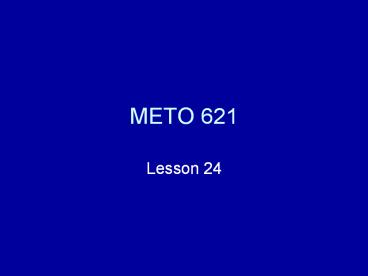METO 621
1 / 15
Title: METO 621
1
METO 621
- Lesson 24
2
The Troposphere
- In the Stratosphere we had high energy photons so
that oxygen atoms and ozone dominated the
chemistry. - In the troposphere we have lower energy photons,
and the chemistry is dominated by the OH and NO3
radicals. - OH is generated photochemically (i.e. only during
the day), NO3 is rapidly photolyzed during the
day, so it can only survive at night. - NO3 is generally less reactive then OH, its peak
concentration is higher. - OH provides an efficient scavenging mechanism for
both natural and anthropogenic trace constituents
3
Dry and Wet Deposition
- Dry deposition removal of gases and particles
by a direct transfer from the atmosphere to the
surface. - Wet deposition removal of gases and particles
carried to the surface in water rain, snow, fog
etc. - Dry deposition is known for SO2, O3, CO2, and
SO3. - Wet deposition of gaseous species requires that
they be water soluble. Terms used are rainout, or
washout. - Acid rain is an example of the rainout of
sulfurous and nitric acids, produced in polluted
atmospheres.
4
Dry and Wet Deposition
5
Oxidation and Transformation
- Let us assume that no methane has been oxidized.
- Then OH is produced by the following reactions
- O3 hn ? O(1D) O2(1Dg)
- O(1D) H2O ? OH OH
- It should be noted that the O(1D) does not stay
around for long, and is quenched to the ground
state. The ground state then quickly combines
with molecular oxygen to reform ozone. - The OH formed reacts mainly with CO and CH4
- OH CO ? H CO2
- OH CH4 ? CH3 H2O
6
Oxidation and Transformation
- These compounds then react with molecular oxygen
- H O2 M ? HO2 M
- CH3 O2 M ? CH3O2 M
- If the concentration of NO is very low then
further reactions convert the peroxy radicals to
water vapor and carbon dioxide. - However if the nitrogen oxides are present then
we get - HO2 NO ? OH NO2
- CH3O2 NO ? CH3O NO2
- This then followed by
- NO2 hn ? NO O
- O O2 M ? O3 M
7
Oxidation and Transformation
8
Oxidation and Transformation
- Analogous reactions can be written for the higher
hydrocarbons, e.g. C8H18 octane. - If we assign the formula RH to these hydrocarbons
then we get - RH OH ? R H2O
- R O2 M ? RO2 M
- RO2 NO ? RO NO2
- This is the basis of photochemical smog.
- The photolysis of the resultant NO2 is the only
known way of producing ozone in the troposphere. - The RO is further reduced to aldehydes and other
organic compounds by OH, all of which can
eventually produce ozone.
9
Oxidation and Transformation
10
Oxidation and Transformation
11
The nitrate radical
- The nitrate radical NO3 plays a significant role
in the troposphere. - It is formed by the reaction
- NO2 O3 ? NO3 O2
- During the day it is rapidly photolyzed
- NO3 hn ? NO2 O or NO O2
- However at night the NO3 is stable and can react
with hydrocarbons - NO3 RH ? HNO3 R
- R can now react with molecular oxygen and begin
the oxidation process
12
The nitrate radical
13
The nitrate radical
14
Chemical lifetimes wrt OH and O3
15
Schematic of biogenic emissions































